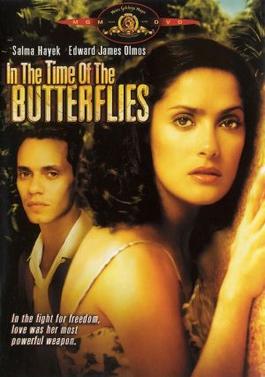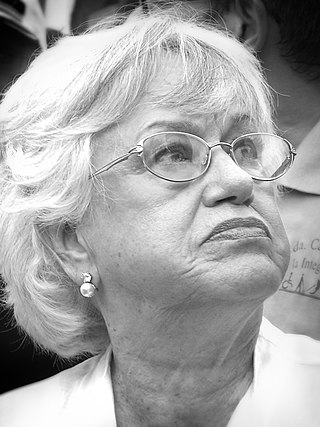
Rafael Leónidas Trujillo Molina, nicknamed El Jefe, was a Dominican military commander and dictator who ruled the Dominican Republic from August 1930 until his assassination in May 1961. He served as president from 1930 to 1938 and again from 1942 to 1952, ruling for the rest of his life as an unelected military strongman under figurehead presidents. His rule of 31 years, known to Dominicans as the Trujillo Era, was one of the longest for a non-royal leader in the world, and centered around a personality cult of the ruling family. It was also one of the most brutal; Trujillo's security forces, including the infamous SIM, were responsible for perhaps as many as 50,000 murders. These included between 12,000 and 30,000 Haitians in the infamous Parsley massacre in 1937, which continues to affect Dominican-Haitian relations to this day.

The Mirabal sisters were four sisters from the Dominican Republic, three of whom opposed the dictatorship of Rafael Trujillo and were involved in clandestine activities against his regime. The three sisters were assassinated on 25 November 1960. The last sister, Adela, commonly known as Dedé, who was not involved in political activities at the time, died of natural causes on 1 February 2014.

In the Time of the Butterflies is a 2001 feature film, produced for the Showtime television network, directed by Mariano Barroso and based on Julia Álvarez's book of the same name. The story is a fictionalized account of the lives of the Mirabal sisters, Dominican revolutionary activists, who opposed the dictatorship of Rafael Trujillo and were assassinated on November 25, 1960.

Santiago de los Caballeros, often shortened to Santiago, is the second-largest city in the Dominican Republic and the fourth-largest city in the Caribbean by population. It is the capital of Santiago Province and the largest major metropolis in the Cibao region of the country. Santiago is the largest Caribbean city that is not a capital city, and it is also the largest non-coastal metropolis in the Caribbean islands. The city has a total population of 771,748 inhabitants (2022). Santiago is located approximately 155 km (96 mi) northwest of the capital Santo Domingo with an average altitude of 178 m (584 ft).

Trópico de sangre is a 2010 drama film based on the true story of the Dominican Republic's heroic Mirabal sisters.
The Miss Dominican Republic is a national beauty pageant in the Dominican Republic.
Antonio de la Maza was a Dominican businessman based in Santo Domingo. He was an opponent of Rafael Trujillo, and was one of the principal conspirators in the assassination of the aforementioned dictator which took place on May 30, 1961.

Dr. Jaime David Fernandez Mirabal is a Dominican psychiatrist, agronomist, and politician.
Miss República Dominicana 2012 was held on 17 April 2012 at the Renaissance Auditorio de Festival del Hotel Jaragua in Santo Domingo, Dominican Republic.

Maximiliano Rabelais Puig Miller is a Dominican politician who served as congressman in the 1990s and Minister of Labor and the Environment in the 2000s.

Minerva Josefina Tavárez Mirabal, known as Minou, is a philologist, professor and politician from the Dominican Republic. Tavárez served as deputy for the National District in the lower House for three terms from 2002 until 2016; she served as deputy minister of foreign affairs from 1996 to 2000.
José Ignacio Ramón Paliza Nouel is a politician and lawyer from the Dominican Republic. He is the President and Chairman of the Modern Revolutionary Party since 14 June 2018, and Administrative Minister of the Presidency since 16 August 2020. He was senator representing the province of Puerto Plata for the 2016–2020 period.

Maria Milagros Ortiz Bosch is a lawyer, business manager and Dominican politician. She was the first Dominican woman to be vice president of the country, during 2000–2004. She was senator of the Distrito Nacional twice and Secretary of State (Minister) for Education of the Dominican Republic, for the same time period she was vice president (2000-2004).
Isabel Mayer (1885-1961) was a Dominican feminist, politician and socialite from the province of Monte Cristi in the Northwest of the Dominican Republic. She was a member of the feminist group Acción Feminista Dominicana (AFD) that helped secure suffrage for women in the Dominican Republic in 1942 under dictator Rafael Trujillo. She served as a senator from her home province from 1942-1944 and also as governor of both Monte Cristi and Santiago. A number of foreign journalists referred to her as a celestina, or madam, for Trujillo during the regime.
Carmen Josefina Lora Iglesias, known as Piky Lora, was a Dominican revolutionary and lawyer who was a part of the 14th of June Movement, a political group opposed to the Trujillo regime. During the guerilla warfare used in the 14th of June movement, Lora was the only woman of 150 participants on the front lines. She also founded the Federation of Dominican Students and the Forge Group, made up of leftist militants.
The Rebellion of the Pilots was a military uprising carried out by six members of the Dominican Military Aviation on November 19, 1961, that put a definitive end to the rule of 31 years of the Trujillo dictatorship by forcing the exile of the Trujillo family from the country. It prevented Ramfis Trujillo, José Arismendy Trujillo and Héctor Bienvenido Trujillo Molina from returning to power and restoring the regime led by their brother Rafael Trujillo.
Antonia María Teresa Mirabal Reyes de Guzmán was a surveyor and political activist from the Dominican Republic. She was one of three sisters assassinated together at the direction of the country's dictator Rafael Leónidas Trujillo.
Carmen Natalia Martínez Bonilla, known simply as Carmen Natalia, was a Dominican feminist poet, essayist, playwright, and activist in opposition to the dictatorship of Rafael Trujillo.
María Argentina Minerva Mirabal Reyes, or Minerva, was the third Mirabal sister, born March 12, 1926, in the Dominican Republic to Mercedes Reyes Camilo and Enrique Mirabal. Like her older sisters, Minerva also received an education at El Colegio Inmaculada Concepción, at the urging of her mother, Mercedes Mirabal. Through their education, Minerva and her sisters began to recognize and speak out against the oppressive dictatorship of Generalissimo Rafael Leonidas Trujillo.
Aniana Ondina Vargas Jáquez was a Dominican democracy and environmental activist. After a period in exile in the United States during the regime of Rafael Trujillo, Vargas returned to the Dominican Republic following his assassination in 1961 where, following the 1963 coup d'état that ousted Trujillo's democratically elected successor, Juan Bosch, she became one of the most prominent female members of the constitutionalist June 14th Revolutionary Movement during the subsequent civil war in 1965. Later in her life, Vargas became known as an environmental activist and land defender, earning the nickname La Madre de las Aguas due to her work on the preservation of the Yuma River.











